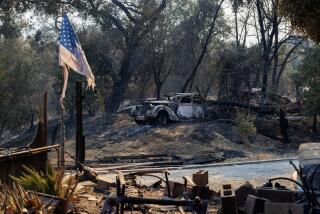Earthquake Insurance Rates to Stay for Now
SACRAMENTO — Insurance Commissioner Chuck Quackenbush is set to put into effect--temporarily--a controversial set of new earthquake insurance rates that would require almost all San Fernando Valley residents to pay 40% more than most of the rest of Los Angeles, key aides say.
The rates, under which homeowners across California will pay vastly different amounts for earthquake insurance, were adopted by the California Earthquake Authority board last month.
When questions were raised about the rate differences, Quackenbush initially said he might reject or modify them before the authority starts up operations Dec. 1. But the two officials he has since appointed to head up the new authority said at a board meeting Friday that it would not be practical.
Greg Butler, the Quackenbush aide named by the commissioner as the authority’s chief executive officer, and Milo Pearson, whom he named as interim chief operations officer, said Quackenbush will almost certainly set a hearing process into motion to examine the rates, a process that could take several months.
The rates were based on calculations of earthquake risks in various parts of the state.
Under the rate structure, most of the San Francisco Bay Area will pay 60% more than central Los Angeles, and parts of Los Angeles’ Westside will pay 60% less than central Los Angeles and less than half as much as the San Fernando Valley. Across the state, there are 19 rating bands.
This is all supposed to reflect the varying degrees of risk, but a number of quake scientists have suggested that there are too many variables and unknowns to make solid judgments of quake risks.
At the same time, it is well known that some parts of the state, such as Humboldt County, the Owens Valley and the Imperial Valley, are more prone to earthquakes than, say, Sacramento.
Wilson has publicly expressed doubts about the widely disparate rates and questioned the need for so many rating bands.
Quackenbush was not present at the board meeting, but Pearson said the issues are too complicated for the commissioner to decide now.
“He can’t just arbitrarily take some rates and alter them” without hearings, Pearson said.
Also at the board meeting, Rick Dinon, of the 20th Century insurance company, said the firm, which is under a Quackenbush order to get out of the homeowners insurance business, wants to remain in the market and retain the 100,000 policyholders it still has.
Quackenbush entered his order after 20th Century’s solvency was threatened by the 1994 Northridge earthquake. The company had concentrated its homeowners policies in the San Fernando Valley and when the quake hit there, it had a very high rate of claims.
Dinon said 20th Century proposes to participate in the earthquake authority and is interested in negotiating an entry price somewhat less than the $50 million it would be required to make as an initial contribution.
If such an arrangement can be made, Dinon said, the company would then ask Quackenbush to lift his order, under which the company has until next July to divest itself of its remaining homeowner policyholders.
In exchange for lowering their exposure to earthquake losses by passing most of it to the state authority, the insurance companies are expected to contribute a total of $1 billion to put the new agency on its feet.
The non-renewal of thousands of policies has left many homeowners searching for new coverage in a very tight market.
Butler appeared dubious about 20th Century’s desires to negotiate a lesser price for entering the earthquake authority, remarking that the law establishing the authority prescribes contribution levels for participating companies, and it is probably illegal to lower rates for just one of them.
More to Read
Sign up for Essential California
The most important California stories and recommendations in your inbox every morning.
You may occasionally receive promotional content from the Los Angeles Times.










